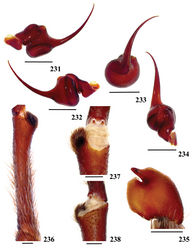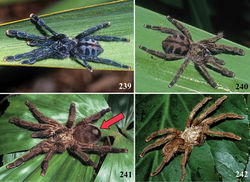Caribena laeta
| Notice: | This page is derived from the original publication listed below, whose author(s) should always be credited. Further contributors may edit and improve the content of this page and, consequently, need to be credited as well (see page history). Any assessment of factual correctness requires a careful review of the original article as well as of subsequent contributions.
If you are uncertain whether your planned contribution is correct or not, we suggest that you use the associated discussion page instead of editing the page directly. This page should be cited as follows (rationale):
Citation formats to copy and paste
BibTeX: @article{Fukushima2017ZooKeys, RIS/ Endnote: TY - JOUR Wikipedia/ Citizendium: <ref name="Fukushima2017ZooKeys">{{Citation See also the citation download page at the journal. |
Ordo: ORDO
Familia: FAMILIA
Genus: Caribena
Name
Caribena laeta (C. L. Koch, 1842) comb. n. – Wikispecies link – Pensoft Profile
- Mygale laeta C. L. Koch, 1842: 66, pl. CCCX, fig. 732 (lectotype female and paralectotype immature, here designated, Puerto Rico, Moritz leg., ZMB 2045, examined); Ausserer 1871[1]: 217; F. O. Pickard-Cambridge 1896[2]: 744.
- Mygale caesia C. L. Koch, 1842: 83, tab. CCCXVII, fig. 744 (syntypes 4 immatures, Puerto Rico, ZMB 2034, examined); F. O. Pickard-Cambridge 1896[2]: 744. Syn. n.
- Avicularia caesia: Simon 1892[3]: 171; Petrunkevitch 1911[4]: 49, 1929[5]: 20, 51, figs 32–35, 1939: 285; Roewer 1942[6]: 254; Bonnet 1955[7]: 830; World Spider Catalog 2016[8].
- Avicularia laeta: F. O. Pickard-Cambridge 1896[2]: 744; Petrunkevitch 1911[4]: 50, 1929[5]: 20, 31, 48, fig. 31, 1939: 287; Mello-Leitão 1923[9]: 377; Roewer 1942[6]: 255; Bonnet 1955[7]: 832; World Spider Catalog 2016[8].
Diagnosis
Females can be distinguished from females of Caribena versicolor comb. n. by almost straight spermathecae with intumescence on their apex (Figs 227–229). Males differ from males of Caribena versicolor comb. n. by lacking prominence on tegulum, by having embolus medial portion and tegulum’s margin forming an obtuse angle in retrolateral view and by slightly curved shape of basal part of embolus in frontal view (Fig. 233).
Material examined
Puerto Rico, Corozal [18°18'N, 66°19'W], 1 female, M. Martinez col., 19 September 1994 (MNRJ 06909); Puerto Rico. Bayamon [18°22'N, 66°09'W], 1 male, 19 November 1932 (AMNH PR).
Additional material
CUBA: 1 female (ZMB 30732); PUERTO RICO: 1 female (ZMB 30757); Road 10, km 21, 1 female, V. Roth col., 12 July 1977, in foliage of Cecropia tree (AMNH RW05); Aibonito [18°08'N, 66°15'W], 1 juvenile female, 1–3 June 1915, ref. 3553 (AMNH PR); 1 immature male (AMNH 1.15); Bayamon [18°22'N, 66°09'W], 1 male, T. Fuentes col., 12 September 1989 (AMNH RW04); Corozal [18°18'N, 66°19'W], 1 male, M. Martinez col., 26 September 1994 (MNRJ 06908); 1 male, same collector, 17 September 1991 (MNRJ 06906); 1 male, same collector, 21 September 1991 (MNRJ 06907); Mayaguez [18°12'N, 67°08'W], Tela: Ninguna, 1 female, A. Ruiz col., 15 February 1962 (AMNH PR); Rio Grande, El Yunque [18°20'N, 65°45'W], 1 female, J. Coffey col., 11 October 1993, in silk retreat in bromeliad (AMNH RW03); 1 male, north slope of Turquillo mountains near El Yunque National Forest [18°17'N, 65°48'W], A. Sanchez col., 29 September 1997 (MNRJ 06905); VIRGIN ISLANDS: Saint John [18°20'N, 64°47'W], 1 female, A. Sanchez col., April 1999, in silken retreat in bromeliad (AMNH RW02); Cinnamon Bay [18°21'N, 64°45'W] trail, about 700 m, 1 immature male, R. Zueifel col., in forest, in a bark, during night, 9 July 1980 (AMNH VI); 1 male, 1 female, Island Project staff col., 18 December 1965 (AMNH VI).
Remarks
The syntypic series of Mygale laeta is constituted by specimens poorly conserved: a specimen without spermatheca (thereafter considered immature) and female with characteristic spermathecae, as reason why it was chosen to be lectotype.
The syntypic series of Mygale caesia is composed of four very small specimens, with central dark longitudinal stripe and dark transversal stripes on each side of abdomen. They retain the green-blue sheen illustrated on the drawings of C. L. Koch (1842)[10], a pattern characteristic of juveniles from many aviculariines. C. L. Koch (1842)[10] described these specimens as being a second species of Mygale in Puerto Rico (the first one was Mygale laeta). However, it is very probable that both are the same species as it was not found any other aviculariine species in Puerto Rico and these immatures are very similar to Caribena laeta comb. n. immatures. Thus, we consider Mygale caesia as the immature stage of Mygale laeta. Since both species were described in the same paper, by page priority Mygale caesia C. L. Koch, 1842 is, herein, considered junior synonym of Mygale laeta C. L. Koch, 1842 new synonymy.
Female
Redescription. AMNH RCW. Carapace: 16.98 long, 14.82 wide, 5.01 high. Chelicera: 7.55 long. Legs (femur, patella, tibia, metatarsus, tarsus, total): I: 13.84, 8.48, 11.16, 9.24, 5.44, 48.16. II: 12.68, 7.52, 9.63, 8.80, 4.84, 43.47. III: 11.87, 6.85, 8.75, 8.73, 4.51, 40.71. IV: 13.88, 7.54, 11.18, 10.89, 3.92, 47.41. Palp: 9.55, 5.71, 6.27, –, 5.97, 27.50. Midwidths: femora I–IV= 3.13, 2.62, 3.08, 3.08, palp= 2.58; patellae I–IV= 3.16, 2.99, 3.18, 3.01, palp= 2.50; tibiae I–IV= 2.45, 2.56, 2.43, 2.73, palp= 2.01; metatarsi I–IV= 1.98, 1.94, 1.89, 1.87; tarsi I–IV= 2.24, 2.07, 2.14, 2.15, palp= 2.28. Abdomen: 23.50 long, 17.64 wide. Spinnerets: PMS, 1.73 long, 0.90 wide, 0.43 apart; PLS, 1.87 basal, 1.67 middle, 2.80 distal; midwidths 1.30, 1.17, 0.76, respectively.
Carapace: 1.15 times longer than wide; cephalic region not raised, thoracic striae inconspicuous.
Fovea: deep, straight, 2.06 wide.
Eyes: eye tubercle 1.07 high, 2.43 long, 3.51 wide. Clypeus 0.20. Anterior row of eyes procurve, posterior row slightly recurve. Eye size and interdistances: AME 0.80, ALE 0.86, PME 0.39, PLE 0.65, AME–AME 0.60, AME–ALE 0.51, AME–PME 0.17, ALE–ALE 2.00, ALE–PME 0.96, PME–PME 1.86, PME–PLE 0.28, PLE–PLE 2.38, ALE–PLE 0.49, AME–PLE 0.57.
Maxilla: length to width: 1.68. Cuspules: 100–200 spread over ventral inner heel. Labium: 2.28 long, 2.73 wide, with 97 cuspules spaced by one diameter from each other on anterior third. Labio-sternal groove shallow, flat, sigilla not evident.
Chelicera: basal segment with 12 teeth and some small teeth on promargin. Sternum: 8.34 long, 6.71 wide. Sigilla: anterior pair not evident, median fusiform, posterior elipsoidal, both less than one diameter from margin.
Legs: Formula: IV=I II III. Length leg IV to leg I: 0.98. Clavate trichobothria: distal 2/3 tarsi I–IV. Scopula: Tarsi I–IV fully scopulate. IV divided by row of setae. Metatarsi I–II fully scopulate; III–IV 1/2 distal scopulate. IV divided by row of setae.
Type II urticating setae (Fig. 243): 1.02–1.33 long, 0.006–0.009 wide.
Spermathecae (Fig. 227): two short, almost straight spermathecae bearing intumescence (not a well-defined lobe) in their apex. Midwidth as wide as its base width and weakly-sclerotized area shorter than half the length of well-sclerotized area.
Color pattern (Fig. 241): carapace brown with golden short body setae. Carapace border long setae the same color as dorsal carapace short body setae. Coxae, labium, sternum and maxillae brown, slightly darker than ventral femora. Legs and palps with golden short body setae with green sheen and dark brown long guard-setae, gradually lightening from base to tip. Leg rings on distal femora, tibiae and metatarsi whitish. Tarsi with an “U” shaped orange stripe. Abdomen with golden brown guard-setae homogeneously distributed and golden short body setae. Ventral abdomen brown. Urticating setae form very distinctive small golden patch on dorso posterior area of abdomen.
Male
Description. AMNH. Carapace: 10.22 long, 8.86 wide, 3.05 high. Chelicera: 2.96 long. Legs (femur, patella, tibia, metatarsus, tarsus, total): I: 11.12, 5.80, 9.30, 8.75, 4.43, 39.40. II: 10.20, 5.03, 8.86, 8.01, 4.77, 36.87. III: 9.20, 4.14, 7.14, 7.91, 4.06, 32.45. IV: 10.57, 4.85, 9.54, 9.48, 4.30, 38.74. Palp: 6.68, 3.90, 5.01, –, 1.76, 17.35. Midwidths: femora I–IV= 1.94, 1.80, 1.77, 1.90, palp= 1.53; patellae I–IV= 1.69, 1.75, 1.72, 1.70, palp= 1.38; tibiae I–IV= 1.53, 1.35, 1.41, 1.40, palp= 1.42; metatarsi I–IV= 1.16, 1.01, 1.02, 1.08; tarsi I–IV= 1.16, 1.07, 1.27, 1.27, palp= 1.29. Abdomen: 9.79 long, 6.92 wide. Spinnerets: PMS, 0.92 long, 0.41 wide, 0.18 apart; PLS, 1.47 basal, 0.80 middle, 1.56 distal; midwidths 0.78, 0.68, 0.48, respectively.
As in female, except:
Carapace: 1.15 times longer than wide.
Fovea: 1.02 wide.
Eyes: eye tubercle 0.73 high, 1.65 long, 2.16 wide. Clypeus absent. Eye size and interdistances: AME 0.61, ALE 0.61, PME 0.27, PLE 0.48, AME–AME 0.31, AME–ALE 0.25, AME–PME 0.11, ALE–ALE 1.27, ALE–PME 0.72, PME–PME 1.17, PME–PLE 0.07, PLE–PLE 1.67, ALE–PLE 0.24, AME–PLE 0.37.
Maxilla: length to width: 1.90. Cuspules: 174. Labium: 1.22 long, 1.45 wide, with 112 cuspules spaced by one diameter from each other on anterior half.
Chelicera: basal segment with 8 teeth and some small teeth on promargin. Sternum: 4.94 long, 3.73 wide. Sigilla: three pairs, posterior rounded, less than one diameter from margin.
Legs: Formula: IV=I II III. Length leg IV to leg I: 0.98. Metatarsus III scopulate in distal 2/3; IV, in distal 1/2.
Type II urticating setae: 1.41–1.71 long and 0.007–0.009 wide.
Palp (Figs 231–234): globous bulb with small subtegulum, lacking prominence on tegulum. Embolus: not flattened, lacking keels, 2.32 long in retrolateral view, about 3 times tegulum’s length. Medial portion and tegulum’s margin form an obtuse angle in retrolateral view. Proximal part slightly curved in frontal view; thin distal width, tapering distally; basal, middle, and distal width of 0.44, 0.12, 0.04, respectively. Tegulum: 1.25 long, 0.74 high in retrolateral view. Cymbium subtriangular with subequal lobes, having well-developed sharp process on retrolateral lobe, bearing thin setae (Fig. 235).
Tibial apophysis (Figs 236–238, 310): single branch on prolateral leg I, with weakly-developed base and grouped spiniform setae distally. Male metatarsus I touches retrolaterally tibial apophysis’ setae when folded.
Color pattern ontogeny
Juveniles with metallic sheen, all articles with same blackish color (Fig. 240), and abdomen dorsum with dorsal central longitudinal black stripe disconnected from transversal black stripes. When mature, they lose this pattern (Figs 241–242).
Distribution
Puerto Rico and the U. S. Virgin Island (Lesser Antilles) (Fig. 226). There is a dubious record of a single specimen from Cuba lacking any information on collectors and date.
Natural history
Petrunkevitch (1929)[5] mention that three females captured in Puerto Rico were found on retreats inside bromeliad leaves. The author also mentioned retreats of this species are similar to retreats of Avicularia species, consisting of a dense silk tube found in leaves and even in human constructions (Petrunkevitch 1929[5]).
Taxon Treatment
- Fukushima, C; Bertani, R; 2017: Taxonomic revision and cladistic analysis of Avicularia Lamarck, 1818 (Araneae, Theraphosidae, Aviculariinae) with description of three new aviculariine genera01 ZooKeys, (659): 1-185. doi
Images
|
Other References
- ↑ Ausserer A (1871) Beiträge zur Kenntniss der Arachniden-Familie der Territelariae Thorell (Mygalidae Autor). Verhandlungen der Zoologisch-Botanischen Gesellschaft (Wien) 21: 117–224. http://www.biodiversitylibrary.org/page/16425408#page/271/mode/1up
- ↑ 2.0 2.1 2.2 Pickard-Cambridge F (1896) On the Theraphosidae of the lower Amazons: being an account of the new genera and species of this group of spiders discovered during the expedition of the steamship “Faraday” up the river Amazons. Proceedings of the Zoological Society of London 1896: 716–766. http://www.biodiversitylibrary.org/page/31200747#page/810/mode/1up
- ↑ Simon E (1892) Histoire naturelle des araignées. Paris, tome 1, 1084 pp. https://doi.org/10.5962/bhl.title.51973
- ↑ 4.0 4.1 Petrunkevitch A (1911) A synonymic index-catalogue of spiders of North, Central and South America with all adjacent islands, Greenland, Bermuda, West Indies, Terra del Fuego, Galapagos, etc. Bulletin of American Museum Natural History 29: 1–791. https://doi.org/10.5962/bhl.title.23819
- ↑ 5.0 5.1 5.2 5.3 Petrunkevitch A (1929) The spiders of Porto Rico. Part one. Transactions of the Connecticut Academy of Arts and Sciences 30: 1–158. https://babel.hathitrust.org/cgi/pt?id=wu.89041295809;view=1up;seq=10
- ↑ 6.0 6.1 Roewer C (1942) Katalog der Araneae von 1758 bis 1940. Bremen 1: 1–1040.
- ↑ 7.0 7.1 Bonnet P (1955) Bibliographie araneorum. Analyse méthodique de toute la littérature aranéologique jusqu’en 1939. Douladoure, Tolouse, Part 2, tome 2, 919–1926.
- ↑ 8.0 8.1 World Spider Catalog (2016). World Spider Catalog. Natural History Museum Bern http://wsc.nmbe.ch, version 17.5
- ↑ Mello-Leitão C (1923) Theraphosoideas do Brasil. Revista do Museu Paulista 13: 1–438.
- ↑ 10.0 10.1 Koch C (1842) Die Arachniden. Nürnberg, 57–108 [9], 1–36 [10]. https://doi.org/10.5962/bhl.title.43744





